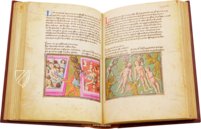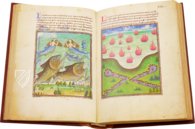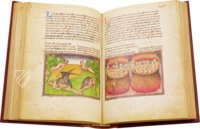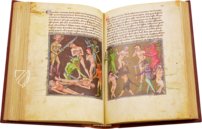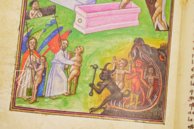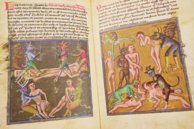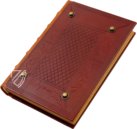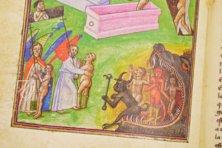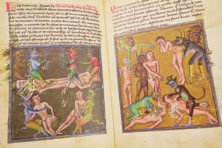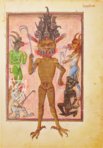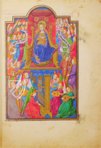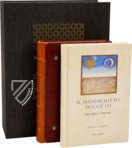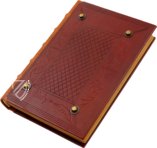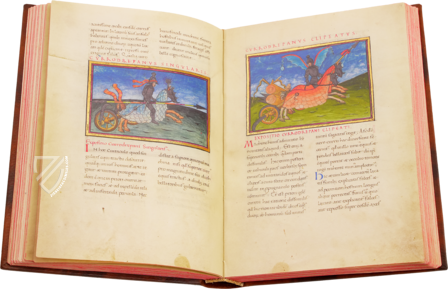Book of the Vineyard
(3,000€ - 7,000€)
This 15th century manuscript is called La Mirabile Visione or The Miraculous Vision and is a treatise regarding the Antichrist, Last Judgement, Heaven, and Hell that is gorgeously adorned in the French Renaissance style. 83 miniatures including 16 full-page miniatures illustrate the Apocalyptic story and have made this masterful manuscript the cherished possession of various noteworthy bibliophiles. This is also a historically valuable witness to the spirit of the Renaissance that synthesizes the religious, humanistic, and artistic values of the period. Witness the horrors and wonders of the Apocalypse and the final triumph of good over evil!
La Mirabile Visione
This fantastic treatise on the Apocalypse is a feast for the eyes and a rejuvenation for the soul. It contains a transcription of the text of the Livre de la Vigne nostra Seigneur or Book of the Lord's Vine, a reference to the parable of vineyard workers found in Matt. 20:1-16. This text is then enriched by quotations from the Bible and the saints Augustine, Jerome, Gregory, Bede, and Bernard. It is adorned by 83 miniatures, 16 of them occupying an entire page. The manuscript is also decorated by numerous red, blue, and gold initials as well as an artful floral border populated by birds and insects framing the first page of text. Nonetheless, La Mirabile Visione contains some of the most extraordinary and terrifying images of the Apocalypse and is endlessly fascinating to researchers and private collectors alike.
Rise and Fall of the Antichrist
The narrative follows the story of the Antichrist, his deceit of humanity, and his war on the Church after he has turned the peoples of earth against it. He is depicted in one miniature as a false pope arriving in Jerusalem, which is just one of several signs of growing discontent within the Catholic Church that boiled over into the Reformation a generation later. After God destroys the Antichrist and brings an end to his persecutions of the faithful, humanity endures 15 signs of the coming end of the world and the Last Judgement. The book is full of violent imagery, particularly with regard to the suffering of the blessed on the orders of the Antichrist and the punishment of the damned after his downfall.
The Zeitgeist of the 15th Century
The text and imagery of the manuscript speak to the anxieties of the 15th century, a period of recovery and rebuilding from the trauma of the war, famines, and plagues of the previous century. It was an era that witnessed both a flowering art and an explosion of literature in the wake of Dante’s Divine Comedy as well as a period of ongoing social upheavals, religious strife, and increasingly brutal warfare. The themes explored in the text would have been extremely captivating for a contemporary audience and continue to be relevant to the modern reader living through our own trying times. Therefore, the work could be seen as an ideal blend of Dante and Giotto that was created shortly before the birth of Michelangelo.
History of the Manuscript
Originally created in Southeastern France by Carthusian monks, this manuscript has passed through the hands of various prominent bibliophiles over the centuries. The manuscript stored today in the University of Oxford’s Bodleian Library under the shelf mark MS. Douce 134 is actually the second of two volumes and the colophon of its sister manuscript bears the date March 5th, 1463 and attests that the second volume had also been completed at the time. The name “Dominus Johannes Blathe” is inscribed in the binding, who likely owned it in the 16th century. It then passed through the hands of Gilbert Paignon Dijonval (1708–1792) and Charles-Gilbert, viscount Morel de Vindé (1759–1842) before being sold to a certain Robert Triphook in April of 1823. The book was then purchased in May of 1832 for the sum of £19 15s by a Mr. Payne, who sold it the next month to the famous collector Francis Douce (1759–1834), who in turn bequeathed it to the Bodleian Library upon his death.
Codicology
- Alternative Titles
- Livre de la Vigne nostre Seigneur
Il Manoscritto Douce 134
Mirabile Visione
Book of the Vineyard of Our Lord
Book of the Vineyard - Size / Format
- 340 pages / 24.0 × 17.0 cm
- Origin
- France
- Date
- Ca. 1450–1470
- Epochs
- Style
- Illustrations
- 83 miniatures, 16 of them full-page
- Content
- Livre de la Vigne nostre Seigneur: treatise on Antichrist, the Last Judgement, Heaven, and Hell
- Artist / School
- Scriptorium of Grande Chartreuse
- Previous Owners
- Dominus Johannes Blathe
Gilbert Paignon Dijonval (1708–1792)
Charles-Gilbert, viscount Morel de Vindé (1759–1842)
Robert Triphook
Mr. Payne
Francis Douce (1757–1834)
La Mirabile Visione
The Twofold Nature of the Antichrist
Dressed in cloth of gold and holding a scepter, the Antichrist is shown with two faces: a fair face that he uses to seduce the peoples of the earth and a devilish visage revealing his true nature. Three figures stand in the foreground including two prosperous-looking farmers holding tools and a richly dressed noblewoman who is gesturing as though giving them instructions. The scene includes many details such as the headgear of the three people and the hardware on the front door of the castle.
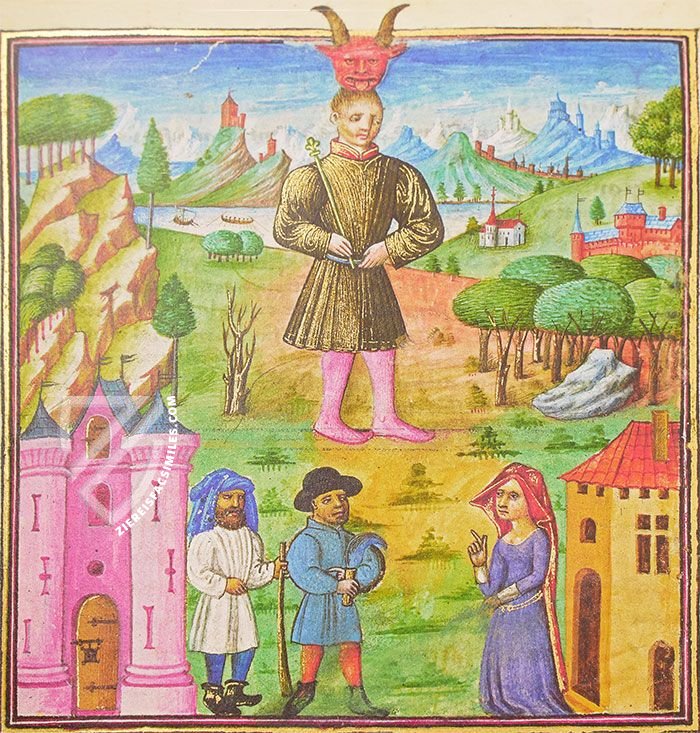
La Mirabile Visione
Judgment of Sinners and Demons
Floating in the sky and revealing the wounds of stigmata while dressed only in a blue cloak, Christ is shown seated in judgment and flanked by the 12 Apostles, who act as heavenly jurors. The Virgin Mary stands over the right shoulder of Christ, perhaps to council mercy, and is adorned with a halo in the same manner of her son and the Apostles. An angelic audience stands back and watches the proceedings.
Those who are on trial stand naked and await their turn to face divine judgment. Among them can be seen two horned demons, a woman with long blonde hair, a tonsured monk, a pope wearing a miter, and three figures who appear to be dancing. While the human figures have serious, fearful expressions, the demons have wide, devilish grins.
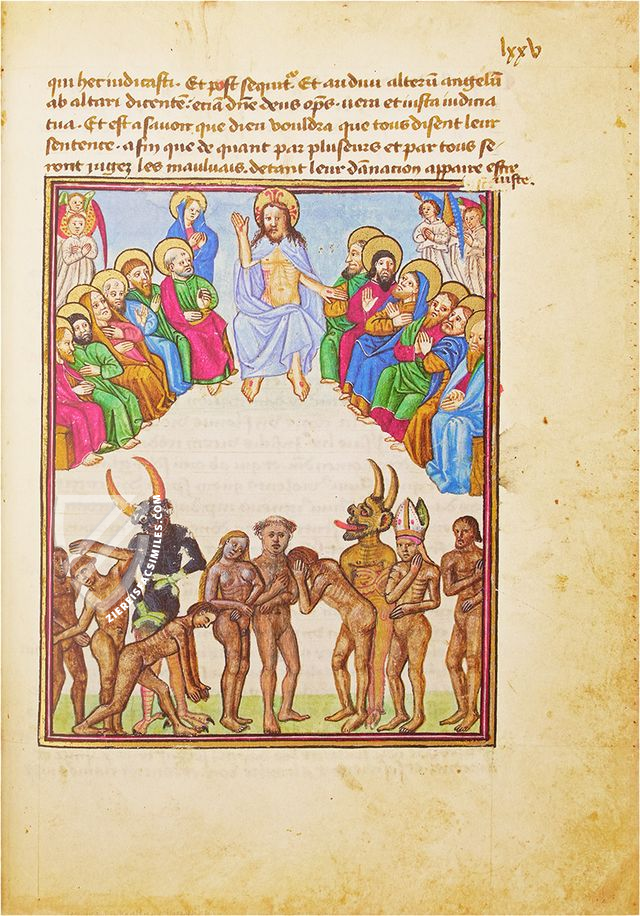
#1 Il Manoscritto Douce 134. Mirabile Visione
Language: Italian
(3,000€ - 7,000€)
- Treatises / Secular Books
- Apocalypses / Beatus
- Astronomy / Astrology
- Bestiaries
- Bibles / Gospels
- Chronicles / History / Law
- Geography / Maps
- Saints' Lives
- Islam / Oriental
- Judaism / Hebrew
- Single Leaf Collections
- Leonardo da Vinci
- Literature / Poetry
- Liturgical Manuscripts
- Medicine / Botany / Alchemy
- Music
- Mythology / Prophecies
- Psalters
- Other Religious Books
- Games / Hunting
- Private Devotion Books
- Other Genres
- Afghanistan
- Armenia
- Austria
- Belgium
- Colombia
- Croatia
- Cyprus
- Czech Republic
- Denmark
- Egypt
- Ethiopia
- France
- Germany
- Greece
- Hungary
- India
- Iran
- Iraq
- Israel
- Italy
- Japan
- Lebanon
- Luxembourg
- Mexico
- Morocco
- Netherlands
- Palestine
- Peru
- Poland
- Portugal
- Russia
- Serbia
- Spain
- Sri Lanka
- Sweden
- Switzerland
- Syria
- Turkey
- Ukraine
- United Kingdom
- United States
- Uzbekistan
- Aboca Museum
- Ajuntament de Valencia
- Akademie Verlag
- Akademische Druck- u. Verlagsanstalt (ADEVA)
- Aldo Ausilio Editore - Bottega d’Erasmo
- Alecto Historical Editions
- Alkuin Verlag
- Almqvist & Wiksell
- Amilcare Pizzi
- Andreas & Andreas Verlagsbuchhandlung
- Archa 90
- Archiv Verlag
- Archivi Edizioni
- Arnold Verlag
- ARS
- Ars Magna
- ArtCodex
- AyN Ediciones
- Azimuth Editions
- Badenia Verlag
- Bärenreiter-Verlag
- Belser Verlag
- Belser Verlag / WK Wertkontor
- Benziger Verlag
- Bernardinum Wydawnictwo
- BiblioGemma
- Biblioteca Apostolica Vaticana (Vaticanstadt, Vaticanstadt)
- Bibliotheca Palatina Faksimile Verlag
- Bibliotheca Rara
- Boydell & Brewer
- Bramante Edizioni
- Bredius Genootschap
- Brepols Publishers
- British Library
- C. Weckesser
- Caixa Catalunya
- Canesi
- CAPSA, Ars Scriptoria
- Caratzas Brothers, Publishers
- Carus Verlag
- Casamassima Libri
- Chavane Verlag
- Christian Brandstätter Verlag
- Circulo Cientifico
- Club Bibliófilo Versol
- Club du Livre
- CM Editores
- Collegium Graphicum
- Collezione Apocrifa Da Vinci
- Comissão Nacional para as Comemorações dos Descobrimentos Portugueses
- Coron Verlag
- Corvina
- CTHS
- D. S. Brewer
- Damon
- De Agostini/UTET
- De Nederlandsche Boekhandel
- De Schutter
- Deuschle & Stemmle
- Deutscher Verlag für Kunstwissenschaft
- DIAMM
- Droz
- E. Schreiber Graphische Kunstanstalten
- Ediciones Boreal
- Ediciones Grial
- Ediclube
- Edições Inapa
- Edilan
- Editalia
- Edition Deuschle
- Edition Georg Popp
- Edition Leipzig
- Edition Libri Illustri
- Editiones Reales Sitios S. L.
- Éditions de l'Oiseau Lyre
- Editions Medicina Rara
- Editorial Casariego
- Editorial Mintzoa
- Editrice Antenore
- Editrice Velar
- Edizioni Edison
- Egeria, S.L.
- Eikon Editores
- Electa
- Emery Walker Limited
- Enciclopèdia Catalana
- Eos-Verlag
- Ephesus Publishing
- Ernst Battenberg
- Eugrammia Press
- Extraordinary Editions
- Fackelverlag
- Facsimila Art & Edition
- Facsimile Editions Ltd.
- Facsimilia Art & Edition Ebert KG
- Faksimile Verlag
- Feuermann Verlag
- Folger Shakespeare Library
- Franco Cosimo Panini Editore
- Friedrich Wittig Verlag
- Fundación Hullera Vasco-Leonesa
- G. Braziller
- Gabriele Mazzotta Editore
- Gebr. Mann Verlag
- Gesellschaft für graphische Industrie
- Getty Research Institute
- Giovanni Domenico de Rossi
- Giunti Editore
- Graffiti
- Grafica European Center of Fine Arts
- Guido Pressler
- Guillermo Blazquez
- Gustav Kiepenheuer
- H. N. Abrams
- Harrassowitz
- Helikon
- Hendrickson Publishers
- Henning Oppermann
- Herder Verlag
- Hes & De Graaf Publishers
- Hoepli
- Holbein-Verlag
- Hortus Deliciarum
- Houghton Library
- Hugo Schmidt Verlag
- Idion Verlag
- Il Bulino, edizioni d'arte
- ILte
- Imago
- Insel Verlag
- Instituto Nacional de Antropología e Historia
- Istituto dell'Enciclopedia Italiana - Treccani
- Istituto Ellenico di Studi Bizantini e Postbizantini
- Istituto Geografico De Agostini
- Istituto Poligrafico e Zecca dello Stato
- Italarte Art Establishments
- J. Thorbecke
- Jan Thorbecke Verlag
- Johnson Reprint Corporation
- Josef Stocker
- Josef Stocker-Schmid
- Jugoslavija
- Karl W. Hiersemann
- Kasper Straube
- Kaydeda Ediciones
- Kindler Verlag / Coron Verlag
- Kodansha International Ltd.
- Konrad Kölbl Verlag
- Kurt Wolff Verlag
- La Liberia dello Stato
- La Linea Editrice
- La Meta Editore
- Lambert Schneider
- Landeskreditbank Baden-Württemberg
- Leo S. Olschki
- Les Incunables
- Library of Congress
- Libreria Musicale Italiana
- Lichtdruck
- Lito Immagine Editore
- Lumen Artis
- Lund Humphries
- M. Moleiro Editor
- Maison des Sciences de l'homme et de la société de Poitiers
- Manuscriptum
- Martinus Nijhoff
- Maruzen-Yushodo Co. Ltd.
- MASA
- McGraw-Hill
- Militos
- Millennium Liber
- Müller & Schindler
- Nahar and Steimatzky
- National Library of Wales
- Neri Pozza
- Nova Charta
- Oceanum Verlag
- Odeon
- Orbis Mediaevalis
- Orbis Pictus
- Österreichische Staatsdruckerei
- Oxford University Press
- Pageant Books
- Parzellers Buchverlag
- Patrimonio Ediciones
- Pattloch Verlag
- PIAF
- Pieper Verlag
- Plon-Nourrit et cie
- Prestel Verlag
- Princeton University Press
- Prisma Verlag
- Priuli & Verlucca, editori
- Pro Sport Verlag
- Propyläen Verlag
- Pytheas Books
- Quaternio Verlag Luzern
- Reales Sitios
- Recht-Verlag
- Reichert Verlag
- Reichsdruckerei
- Riehn & Reusch
- Roberto Vattori Editore
- Rosenkilde and Bagger
- Roxburghe Club
- Salerno Editrice
- Sarajevo Svjetlost
- Schöck ArtPrint Kft.
- Scolar Press
- Scrinium
- Scripta Maneant
- Scriptorium
- Siloé, arte y bibliofilia
- SISMEL - Edizioni del Galluzzo
- Sociedad Mexicana de Antropología
- Société des Bibliophiles & Iconophiles de Belgique
- Soncin Publishing
- Sorli Ediciones
- Stainer and Bell
- Studer
- Styria Verlag
- Sumptibus Pragopress
- Szegedi Tudomànyegyetem
- Taberna Libraria
- Tarshish Books
- Taschen
- Tempus Libri
- Testimonio Compañía Editorial
- Thames and Hudson
- The Clear Vue Publishing Partnership Limited
- The Facsimile Codex
- The Folio Society
- The Marquess of Normanby
- The Richard III and Yorkist History Trust
- Tip.Le.Co
- TouchArt
- TREC Publishing House
- TRI Publishing Co.
- Trident Editore
- Typis Regiae Officinae Polygraphicae
- Union Verlag Berlin
- Universidad de Granada
- University of California Press
- University of Chicago Press
- Urs Graf
- Vallecchi
- Van Wijnen
- VCH, Acta Humaniora
- VDI Verlag
- VEB Deutscher Verlag für Musik
- Verlag Anton Pustet / Andreas Verlag
- Verlag Bibliophile Drucke Josef Stocker
- Verlag der Münchner Drucke
- Verlag für Regionalgeschichte
- Verlag Styria
- Vicent Garcia Editores
- W. Turnowsky
- Waanders Printers
- Wiener Mechitharisten-Congregation (Wien, Österreich)
- Wissenschaftliche Buchgesellschaft
- Wydawnictwo Dolnoslaskie
- Xuntanza Editorial
- Zakład Narodowy
- Zollikofer AG




